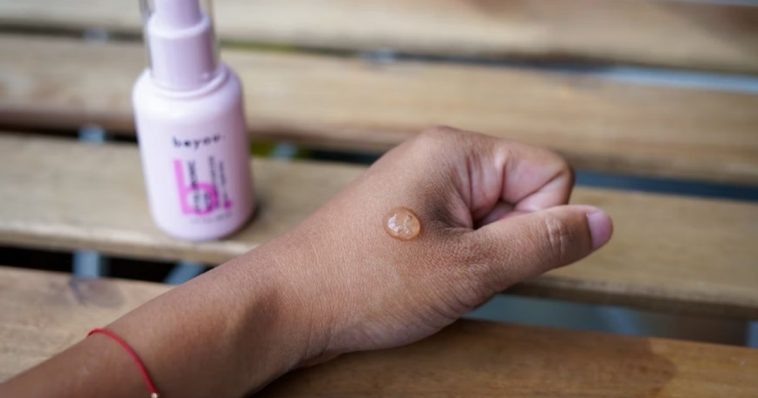Moisturising might seem straightforward—apply a cream or lotion and voilà, hydrated skin! But surprisingly, many people unknowingly undermine their skin’s health with common moisturising missteps. The skin barrier, that crucial outer layer protecting against moisture loss and environmental aggressors, can be compromised when moisturising goes wrong. This article highlights 10 frequent mistakes that sabotage the skin barrier and offers tips to help restore and protect the skin barrier for glowing, resilient skin.
10 Moisturising Mistakes Wrecking Your Skin Barrier (53)
1. Applying Moisturiser on Dry Skin
Timing significantly impacts the effectiveness of moisturiser application. Delaying application until the skin is fully dry—particularly several minutes post-shower—can result in the loss of valuable hydration. Water evaporation from the skin’s surface draws out internal moisture, heightening the likelihood of dryness, tightness, and weakened barrier integrity.
Following the “three-minute rule,” where moisturiser is applied while the skin remains slightly damp, helps trap surface moisture and enhances the absorption of hydrating agents like glycerin and hyaluronic acid. This simple timing adjustment improves moisturiser performance and supports longer-lasting hydration, transforming a basic skincare step into a more restorative practice.
2, Using Products With Harsh Ingredients
The performance of a moisturiser depends not just on its thickness or richness, but also on the quality of its formulation. Products that include irritating or sensitising components—such as synthetic fragrances, drying alcohols, parabens, or harsh preservatives—can disturb the skin’s natural equilibrium and trigger redness, inflammation, or discomfort. This is especially problematic for skin that is sensitive, dry, or already compromised.
A more effective approach lies in using formulations that support and strengthen the skin. Ingredients like ceramides help rebuild the lipid barrier, hyaluronic acid attracts and retains moisture, and emollients such as shea butter and squalane lock in hydration while adding a layer of protection. Opting for formulations aligned with the skin’s natural function promotes healthier, more resilient skin over time.
3, Over-Moisturising or Under-Moisturising
Finding the right balance in moisturising is crucial for maintaining a healthy skin barrier. Applying too much moisturiser—particularly rich or occlusive formulas on skin that doesn’t require it—can clog pores, lead to congestion, and interfere with the skin’s natural oil production. This may result in breakouts or increased sensitivity over time. Conversely, insufficient moisturising deprives the skin of the hydration it needs to stay supple and resilient, leading to dryness, tightness, flaking, and a compromised barrier that’s more vulnerable to external aggressors.
Tailoring the level of hydration to match both skin type and environmental conditions helps prevent these issues. Lightweight, oil-free lotions or gels are ideal for oily or acne-prone skin, offering hydration without heaviness. For drier or compromised skin, especially in colder months, thicker creams or ointments with ingredients like ceramides, glycerin, or shea butter deliver lasting moisture and barrier repair. Personalised moisturising—rather than a one-size-fits-all approach—keeps skin balanced, calm, and better equipped to defend itself.
4. Ignoring Body Moisturising
Neglecting body moisturization leaves large areas of skin vulnerable to dryness, irritation, and damage—especially in high-friction or frequently exposed regions. The skin on the body, much like the face, faces daily challenges from environmental factors, hot showers, clothing friction, and shaving. Over time, skipping this essential step can result in rough textures, flakiness, and increased sensitivity. Commonly, dry spots like elbows, knees, and shins often show the first signs of barrier disruption when not properly hydrated.
Incorporating daily body moisturising—particularly after showering, when the skin is most receptive to hydration—restores lost moisture and strengthens the lipid barrier. Using rich, fragrance-free creams or body balms with barrier-repairing ingredients such as ceramides, shea butter, and urea can soothe and protect sensitive areas for specific concerns like keratosis pilaris. Targeted treatments containing exfoliants like lactic acid or salicylic acid offer smoother, more refined skin. Prioritising body moisturization ensures that the entire skin surface—not just the face—remains healthy, resilient, and protected.
5. Skipping Sunscreen After Moisturising
While moisturiser supports hydration, it offers no defence against one of the most damaging environmental factors: UV radiation. Without sunscreen, the skin remains vulnerable to UVA and UVB rays, which can accelerate collagen breakdown, promote pigmentation, and compromise the skin’s protective barrier. This ongoing exposure not only speeds up visible signs of ageing but also heightens the risk of developing skin cancer. UV rays can penetrate clouds and glass, meaning unprotected skin is still at risk even on cloudy days or when indoors near windows. Optimal protection is achieved by using a broad-spectrum sunscreen with an SPF of 30 or higher as the final step in the morning skincare routine.
Priority should be given to frequently exposed areas like the face, neck, chest, arms, and hands. Reapplication every two hours is advised during prolonged outdoor exposure or following perspiration. Incorporating this step into daily routines reinforces the skin’s natural defences, supports an even tone and smooth texture, and helps maintain the benefits of moisturisers by guarding against environmental damage.
6. Not Layering Moisturisers Properly
Layering plays a crucial role in optimising skin hydration, yet it’s often neglected. Applying a thick cream to dry skin can result in the formation of a superficial barrier, limiting moisture penetration to the deeper layers. The result is a greasy surface with underlying dryness, preventing the skin from receiving the nourishment it needs. A strategic layering method, one that mimics the skin’s natural moisture process, can significantly improve overall hydration.
The ideal approach begins with a lightweight, water-based serum or hydrating essence containing ingredients such as hyaluronic acid, glycerin, or panthenol to attract and bind moisture. Once the skin absorbs this layer, a richer cream or ointment can be applied to lock in hydration and reinforce the barrier. This process allows each product to work at its full potential—hydrating deeply while minimising moisture loss. Over time, consistent layering supports improved elasticity, radiance, and resilience, promoting a more balanced and visibly healthier complexion.
7. Using the Wrong Moisturiser for Your Environment
Skin’s hydration needs can shift dramatically with changes in climate, weather, and even indoor conditions. A moisturiser that feels perfect during humid summer days might prove ineffective—or overly heavy—once cold, dry air sets in. Environmental stressors such as wind, low humidity, and artificial heating or cooling systems can dehydrate the skin and compromise its barrier function. Ignoring these variables often results in either under-moisturised, flaky skin or congestion and breakouts from using overly rich formulas in unsuitable settings.
To maintain balance, moisturiser formulas should be adapted to match the surrounding conditions. In colder months or high-altitude areas, thicker creams containing occlusive ingredients like petrolatum, ceramides, and shea butter create a protective layer that locks in hydration and shields against harsh elements. During warmer or more humid seasons, lightweight, water-based gels or non-comedogenic lotions allow the skin to stay moisturised without clogging pores or feeling greasy. Adjusting moisturiser choices based on the environment keeps the skin resilient, supple, and better equipped to withstand seasonal shifts.
8. Relying Solely on Moisturisers Without Addressing Underlying Issues
Persistent dryness, redness, or irritation may not always stem from a lack of moisture—it can be the skin’s way of signalling a deeper concern. Conditions such as eczema, contact dermatitis, psoriasis, or allergic reactions often mimic symptoms of simple dryness but require more than over-the-counter moisturisers to resolve. While a rich cream can provide temporary relief, it won’t address inflammation, barrier dysfunction, or immune responses driving the problem.
In such cases, a dermatologist may recommend targeted treatments like topical steroids, non-steroidal anti-inflammatories, or prescription-strength barrier-repair formulas. Identifying the root cause early allows for more effective interventions and helps prevent chronic damage or flare-ups. Moisturisers remain important, but they should work in tandem with a broader plan tailored to the skin’s specific needs.
9. Skipping Exfoliation, Leading to Build-Up
Neglecting exfoliation can quietly sabotage even the best moisturizing efforts. When dead skin cells accumulate on the surface, they form a barrier that prevents moisturisers from fully absorbing, leaving the skin feeling dull, rough, or persistently dry despite regular hydration. Regular exfoliation—particularly with gentle chemical exfoliants like lactic acid, mandelic acid, or salicylic acid—can help slough off this build-up and improve product efficacy.
These acids work by dissolving the bonds between dead cells, promoting smoother texture and better hydration retention. However, exfoliating too often or using abrasive scrubs can backfire, stripping away healthy cells and weakening the barrier. A balanced approach—typically once or twice a week—is enough to keep skin receptive to moisture without compromising its integrity.
10. Applying Moisturiser With Harsh Tools or Techniques
How moisturiser is applied plays just as vital a role as the product itself. Using abrasive tools like rough loofahs, dry brushes, or applying excessive pressure while rubbing can create microtears in the skin’s surface, disrupt the lipid barrier, and trigger inflammation—especially in sensitive or compromised skin. Even well-formulated moisturisers can lose effectiveness if the application method causes trauma to the skin.
Instead, dermatologists recommend using clean fingertips or a soft, damp cloth to pat or press moisturiser into the skin gently. This technique not only minimises friction and irritation but also encourages better absorption of hydrating ingredients. Gentle, upward strokes help boost circulation and leave the skin feeling soothed and nourished rather than stressed. When it comes to supporting the skin barrier, a light touch goes a long way.
Moisturising as Self-Care
Every step, from selecting the right product to how and when it’s applied, affects skin barrier health. Moisturising is a skill, and mastering it means listening to the skin’s needs, adjusting routines thoughtfully, and choosing gentle yet effective products. Prioritising barrier repair transforms moisturising from a chore into an empowering act of self-care, unlocking skin that’s not only hydrated but resilient and glowing with vitality.



